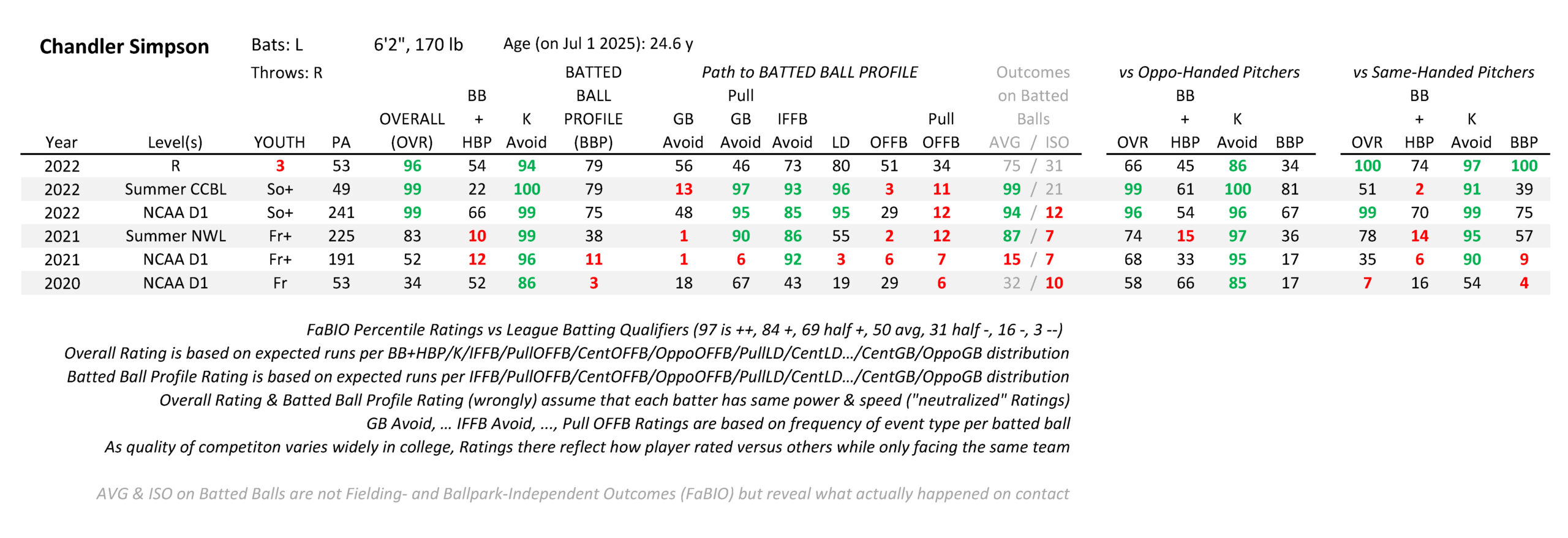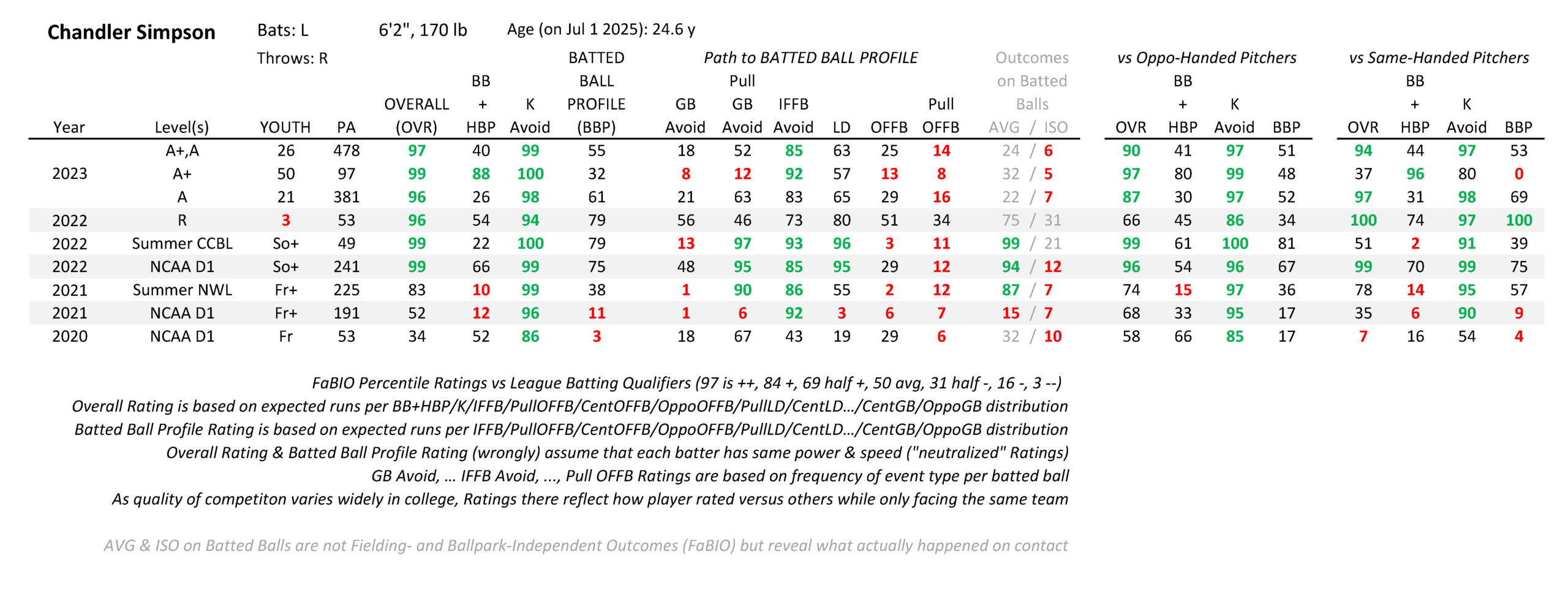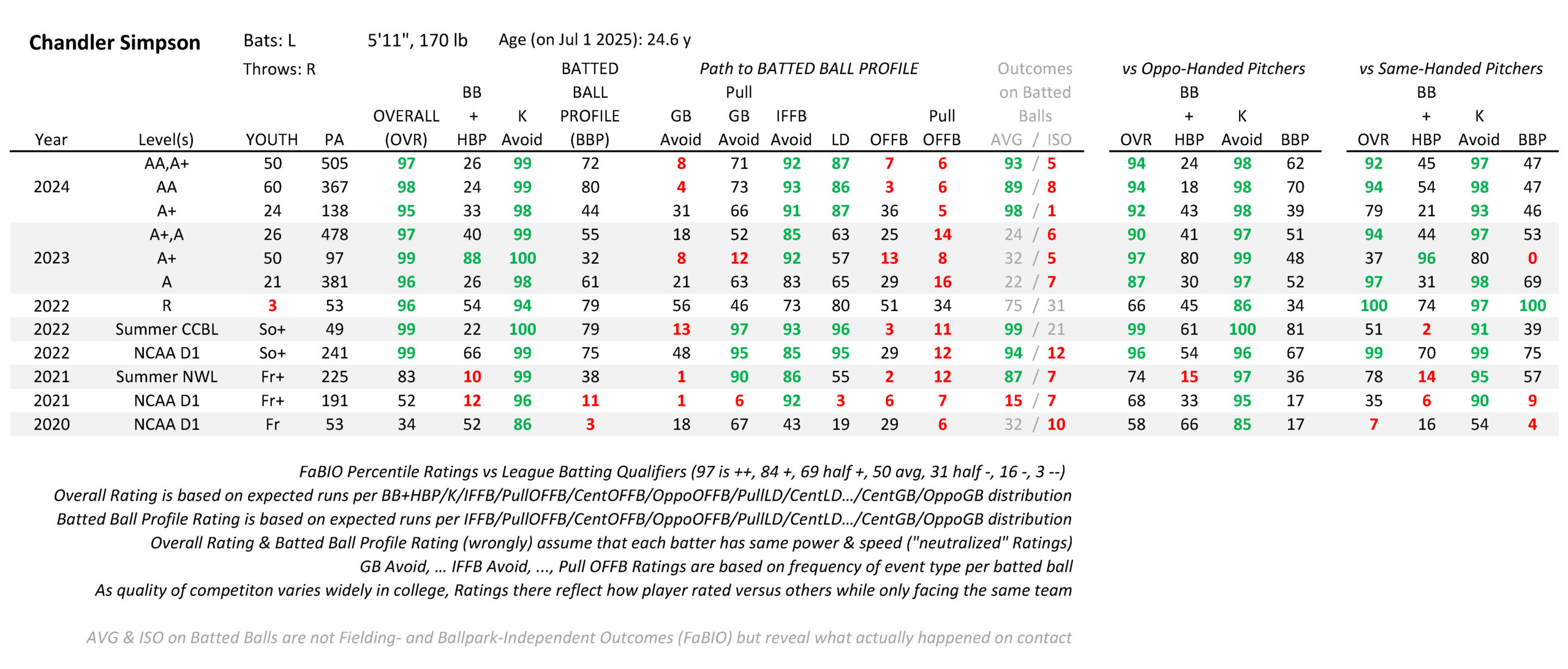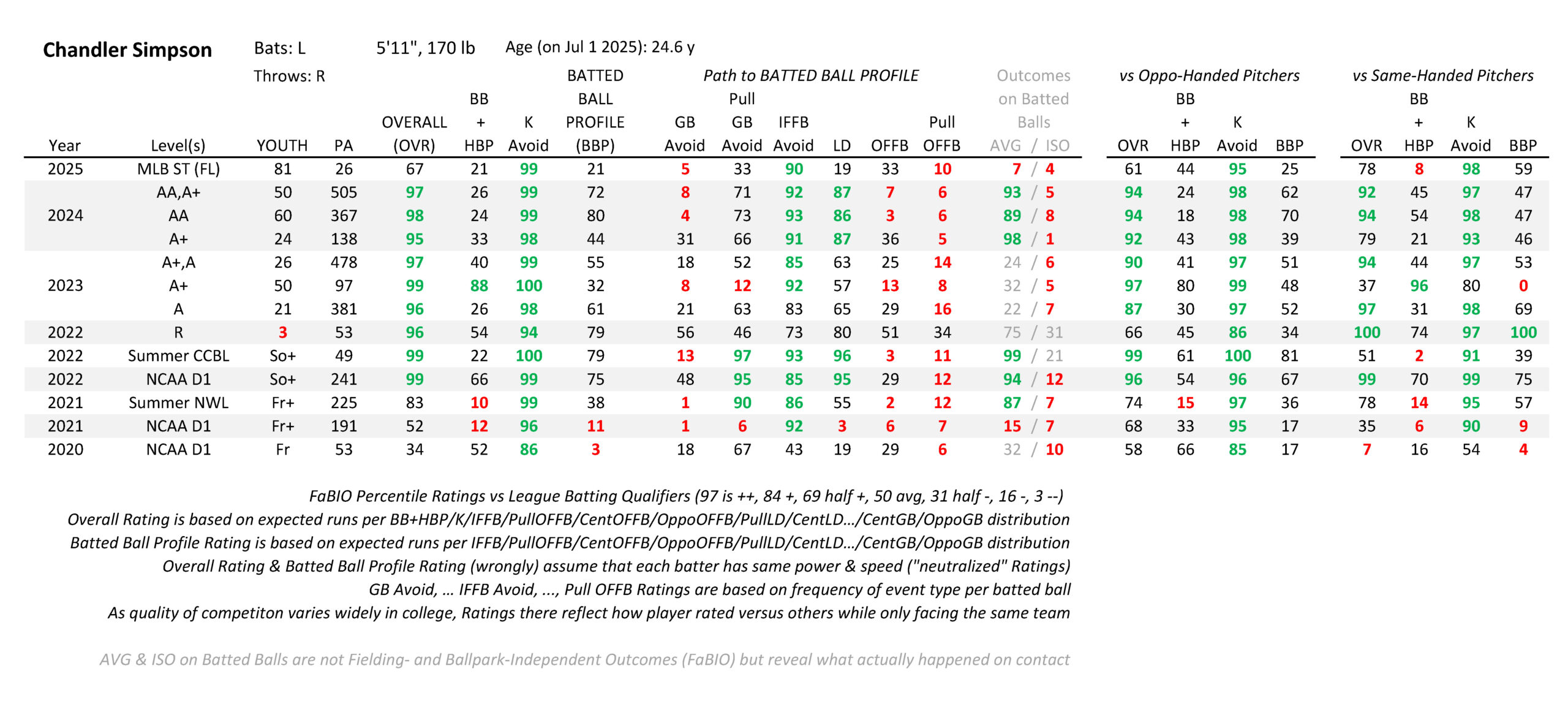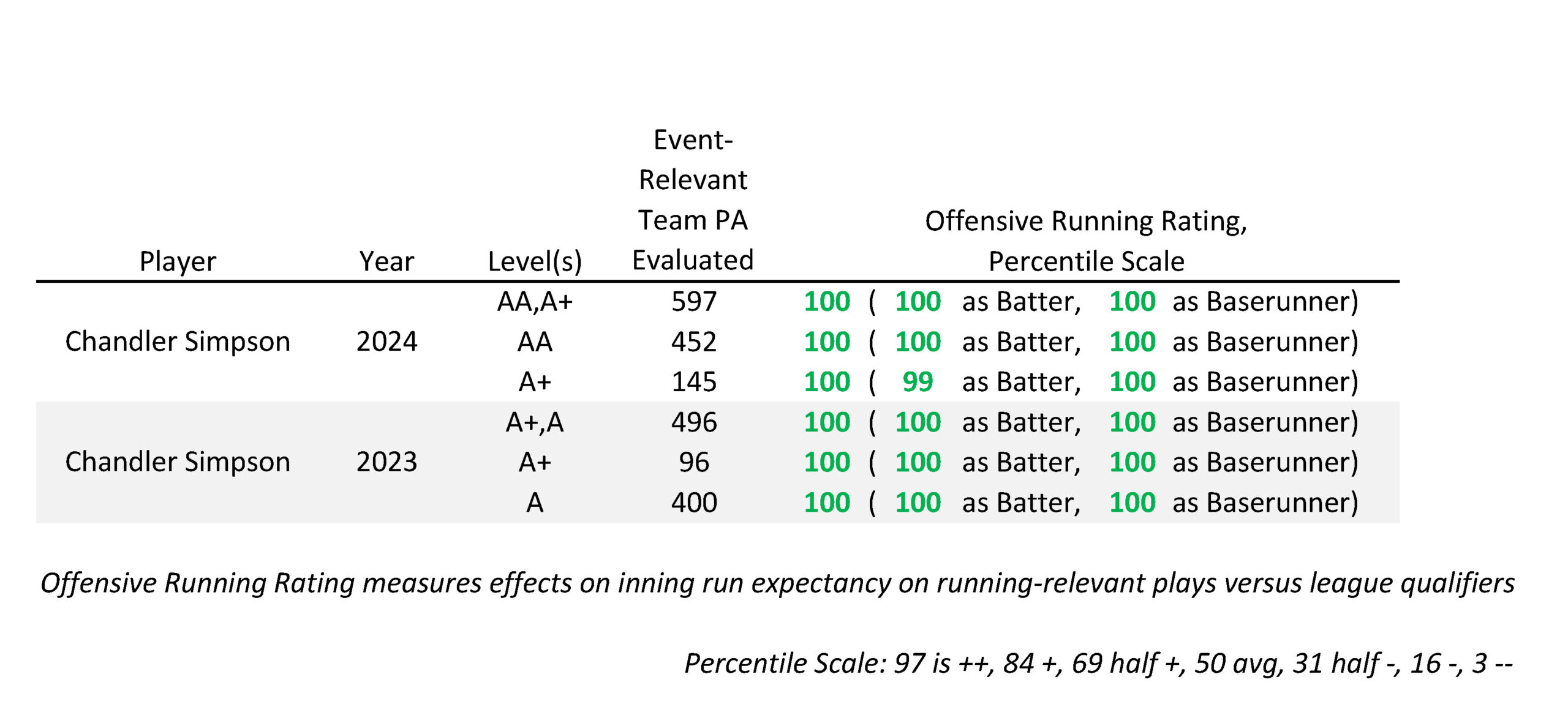Chandler Simpson's fantasy baseball prospect outlook, sleeper potential for dynasty leagues. Matt uses his custom suite of fundamentals-rooted evaluation tools.
Rays recently selected the minor league contract of wiry sprinter-outfielder Chandler Simpson, who immediately becomes an MLB must-watch offensive runner when he is the batter or on base while a teammate fills the box.
While media types often reference the triple-plus scout scale speed grades, my model, featured in this article, objectively quantifies Simpson's 2024 and 2023 minor league in-game offensive running as triple-and-a-half to quadruple-plus relative to same-circuit position player qualifiers.
What elements would the batting plate profile ideally feature to maximize offensive opportunities for Simpson to leverage his outlier speed? Let's take a look while also explaining why Simpson is one to watch for the long-term future.
Be sure to check all of our fantasy baseball lineup tools and resources:- Fantasy baseball trade analyzer
- BvP matchups data (Batter vs. Pitcher)
- PvB matchups data (Pitcher vs. Batter)
- Who should I start? Fantasy baseball comparisons
- Daily MLB starting lineups
- Fantasy baseball closer depth charts
- Fantasy Baseball live scoreboard
- Fantasy baseball injury reports
Brief Explanation of the FaBIO Model
My Fielding- and Ballpark-Independent Outcomes (FaBIO) evaluation model sorts every plate appearance into one of 12 outcome bins (BB+HBP, K, IFFB, Pull-Third OFFB, Center-Third OFFB, Oppo-Third OFFB, Pull-Third LD, Center-Third LD, Oppo-Third LD, Pull-Third GB, Center-Third GB, Oppo-Third GB) and charges the pitcher and batter with their league's mean runs value for said particular event that season.
Dividing a batter's total number of expected runs by plate appearance (PA) yields expected runs per PA that can be percentile ranked relative to the league mean and standard deviation for that parameter amongst league batter qualifiers to arrive at their Overall Rating.
Its three subcomponents of BB+HBP Rating (based on BB+HBP per PA), Strikeout Avoid Rating (K Avoid, based on K per PA), and Batted Ball Profile Rating (expected runs per batted ball) are also reported to identify the path the batter traveled to reach their Overall Rating.
Overall Rating and Batted Ball Profile Rating of batters should be considered power- and speed-neutralized metrics since the real-world runs value of a single batter's typical OFFB or LD varies with their strength, and the expected runs value of their typical GB varies with their speed.
To better understand the Path to Batted Ball Profile, we will also examine percentile ratings for select batted ball event types (on a per-batted ball basis). To check how well expected batted ball outcomes match real-world ones, we will compute percentile ratings for hits (AVG) and isolated power (ISO, or simply extra bases) on batted balls (recognizing full well that these two parameters are neither fielding- nor ballpark-independent outcomes).
What most explains a batter's ability to generate hits (AVG) on batted balls is any LD, IFFB avoidance, Pull-Third OFFB, and Pull-Third GB avoidance. What most explains their ability to generate extra bases (ISO) on batted balls is any OFFB, Pull-Third OFFB, Pull-Third LD, and IFFB avoidance.
A percentile rating of 97 amounts to plus-plus (two standard deviations above the mean), 84 is plus (one standard deviation above the mean), 69 is half plus, 50 is average, 31 is half minus, 16 is minus, and three is minus-minus.
A new addition to this suite of evaluation models is the Offensive Running Rating. This tool quantifies how each relevant inning's run expectancy was impacted by the player's action or inaction as either a batter or baserunner on specific types of plays that are more likely to involve one or both of their speed, offensive running technique, and acumen.
The evaluated batter and baserunner events are summarized in the graphic.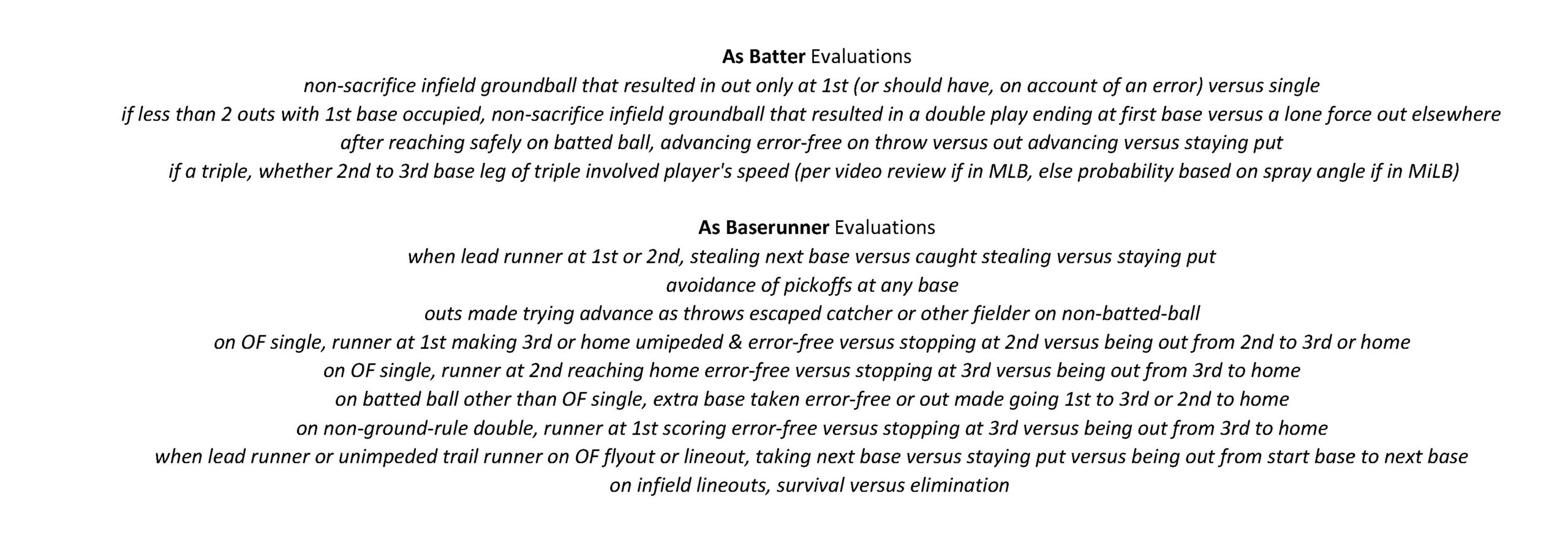
Prospect Analysis: Chandler Simpson
Evolution of College Plate Profile
Simpson played a pandemic-shrunk freshman 2020 season and a second freshman 2021 season at the University of Alabama-Birmingham.
The speedster began to attract MLB scouting attention during a summer 2021 Northwoods League stay in which he tallied 55 steals in 65 tries, posting a singles-heavy .378 batting average. He decided to transfer to Georgia Tech via portal for the 2022 spring season. There, he swiped 27 bags in 31 attempts and hit .434, with a modicum of doubles and triples, and what would be the lone home run of his college career.
For a Simpson-like slighter player who lacks strength but possesses top-of-the-scale speed, the ideal plate profile mix involves high BB+HBP, high K Avoid, and a lower-launch (low to very low GB Avoid and OFFB Rating) batted ball profile that is thick on LD + IFFB Avoid + Pull GB Avoid (they spray line drives from foul line to foul line while mostly else hitting groundballs up/into the middle or through/into the opposite-field hole).
Simpson had only established the K Avoid and IFFB Avoid elements of such by the completion of his second freshman season. He produced a plus AVG on batted balls that summer when LD and Pull GB Avoid Ratings rose around IFFB Avoid to arrive at a more formidable "hit trio". The LD + IFFB Avoid + Pull GB Avoid hit trio soared still nearer to perfection along with AVG during the 2023 D1 and 2023 summer Cape Cod League stops. BB+HBP nearly reached half plus in 2023 D1 before fading on Cape.
Rays selected Simpson as the 70th pick of the 2022 MLB Draft prior to the start of Round Three, with a signing bonus of $747,500 in place.
Evolution of Pro Plate Profile
Rays then kept the lesser-armed collegiate middle infielder in the Rookie-level Florida Complex League to ease a transition to full-time center or left field play.
While there, he seldom whiffed and flashed a reasonably good hit trio that produced a 75 AVG on batted balls.
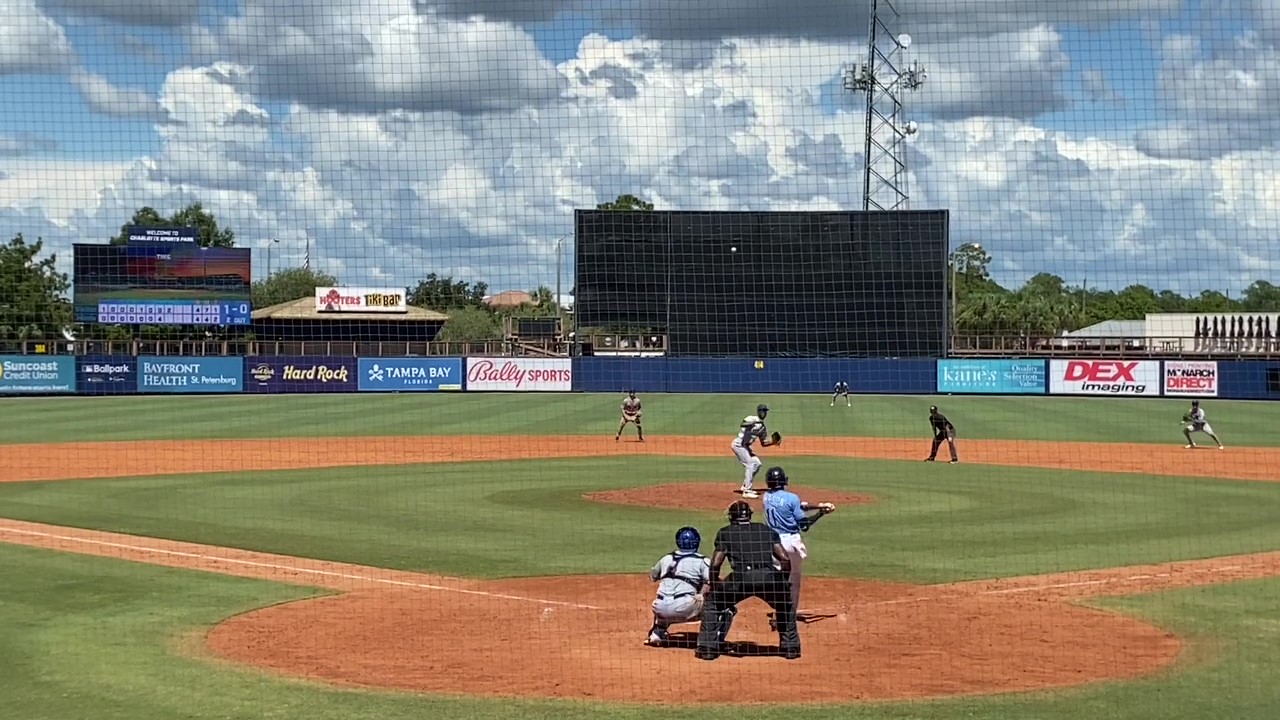
In 2022, Florida Complex League action that I filmed, Simpson loops a liner that falls safely in front of the shallowly-positioned center fielder to plate a runner from 3rd base.
Simpson would struggle to generate AVG on Batted Balls during a 2023 that began with 381 PA in Low-A and ended with 97 more in High-A. LD rated 65 in Low-A, 57 in High-A.
K Avoid registered 98 at the first stop, then 100 at the latter. BB+HBP Avoid rose from just 26 in Low-A to 88 in High-A.
Simpson hit LD at above-average rates during the 2024 season in each of High-A and Double-A, which in turn set the table for first a 98 and later an 89 AVG on Batted Balls.
Relative surpluses of line drives were further needed, since the 2024 High-A and Double-A BB+HBP Ratings were each circa half minus, or comparable in magnitude to the large-sample 2023 Low-A one. Both 2024 K Avoids registered above double plus, consistent with the prior campaign.
Simpson made 26 plate trips in 2025 MLB spring training games. A 99 K Avoid was countered by a low on-base percentage pairing of 19 LD and 21 BB+HBP.
Hindered by 19 LD and 33 Pull GB Avoid Ratings sandwiched around a 90 IFFB Avoid, Simpson could only generate a single-digit AVG on Batted Balls.
Evolution of Pro Offensive Running
The percentile scale scheme used in the table belies just how fast Simpson plays offensively. The 2024 and 2023 seasonal 100 Offensive Running Ratings were 3.4 and 3.8 standard deviations, respectively, above the mean of his combined leagues' offensive running qualifiers.
Each of the two seasonal marks led all minor league offensive running qualifiers and would round up to 85 and 90, respectively, on the traditional 20-to-80 scout scale. This in-game-play-event-referencing model asserts that Simpson should presently be graded in the range of triple plus to quadruple plus as an offensive runner.
Dynasty Fantasy Baseball Focus
For lack of much longball threat from Simpson, MLB pitchers are more likely to challenge the center than the outer fringes of the strike zone. Such will force him to be keen-eyed and foul-spoil (rather than centered offerings, which are difficult) his way to a walk frequency that should rate at least a few ticks below the 50th percentile by MLB batter standards.
A relative lack of walk plus hit-by-pitches early on, if not longer, requires Simpson to hit line drives at an above-average clip per batted ball if he is to occupy a semi-regular lineup spot in this or future seasons. Expect Simpson not hitting over-the-fence home runs to be discussed far too often while the culprit largely ignores how essential line drives are to his winning offensive formula. Also, remember that absolutely any MLB position player can over-the-fence homer in contemporary conditions. Myles Straw needed all of five MLB plate trips to park one... to center field (not to the easily reachable left field seats in Houston).
Instead, Simpson creates extra bases by stretching his own singles into doubles and stray doubles into triples... or in a virtual sense by stealing second, if not also third later, after reaching first with second unoccupied, taking an extra ninety feet on singles of others, etc. much more frequently than a typical league baserunner does.
Between not striking out, seldom popping out to infielders, and rarely lofting outfield flies to center or left field, the lefthanded batter is positioned to constantly apply pressure to one or more of the pitcher, catcher, infielders, and outfielders. He has already shrunk the frequency of easy outs to a minimum, opening many doors for his speed to wreak mental and physical havoc. Line-to-line low- to medium-launch-angled liners, groundballs up the middle and to the 6-5 hole, bunts and other choppers, and slower rollers with variable spray serve as the primary vehicles for the catalyst.
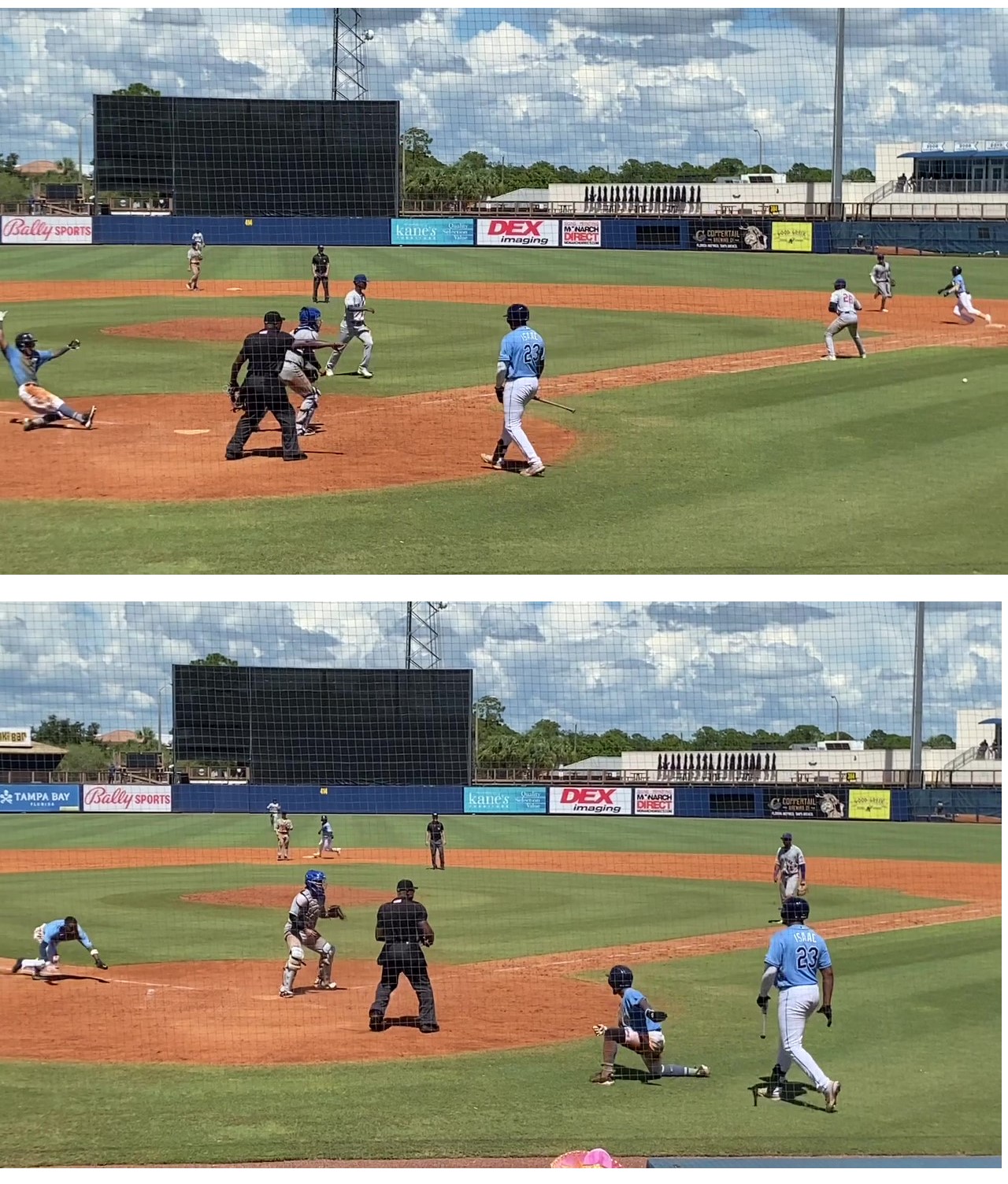
On shallow right field single, runner from 2nd slides home as inbound throw trickles behind first baseman. Ever-alert Simpson dashes then dives for the plate to complete the first-to-home score.
Had Simpson long ago established himself as a center fielder who can be an impact defender in multiple dimensions, the relative volume of line drives and hits in general produced would not occupy quite so much weight in his prospective playing time decisions. For relative lack of outfield experience and arm strength, Simpson mostly needs to use his beyond triple-plus speed to catch, else cut off what many others would not, while playing a relatively error- and mental-gaffe-free brand of center and left field defense.
In the wake of Simpson seldom hitting line drives in MLB spring games and only having a total of 78 Triple-A plate trips under his belt at the time of his MLB regular-season debut, the smart money would be on that he will not line very many MLB pitches for hits in the next month, perhaps two.
But, realistically, Simpson could produce half-plus hits per batted ball as early as 2025 to the middle of 2026 and emerge then as an everyday regular centerfielder who delivers fantasy owners 70 to 90 steal peak seasons and perhaps 100 runs scored. Such a fortuitous outcome would require that he spray-hits well enough to offset fewer free passes and settles in to bat leadoff or second in the order rather than be banished to the "second leadoff" nine spot.
Download Our Free News & Alerts Mobile App
Like what you see? Download our updated fantasy baseball app for iPhone and Android with 24x7 player news, injury alerts, sleepers, prospects & more. All free!

More Fantasy Baseball Advice

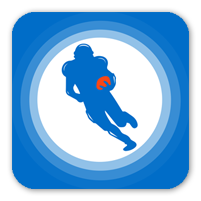



 RADIO
RADIO









